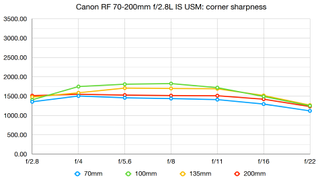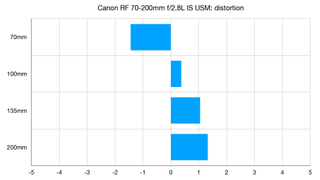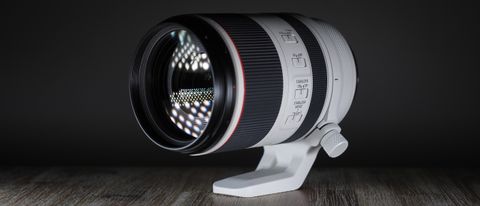The Canon RF 70-200mm f/2.8L IS USM is potentially a make-or-break lens for the EOS R system. When Canon launched its full-frame mirrorless range in 2018, many pros and gear heads refused to consider the system until a) it had a professional body with two memory card slots, and b) it had the professional f/2.8 'trinity lenses'.
Of course, today we have the Canon EOS R5 and Canon EOS R6, both with dual card slots, along with some of the best Canon RF lenses we could have hoped for – including the Canon RF 15-35mm f/2.8L IS USM and Canon RF 24-70mm f/2.8L IS USM trinities. However, it's the RF 70-200mm that has been most eagerly anticipated – and it's the one by which many will judge the entire system.
The 70-200mm has become a must-have lens for professionals and amateurs alike. The versatile zoom range makes it a useful tool for everything from portraiture to action, making it a staple of portrait, wedding, event and sports photography – any pro worth their salt has this lens in their bag, and most enthusiasts dream of doing the same.
So how does the Canon RF 70-200mm f/2.8L IS USM – a potential system seller for Canon's EOS R range – actually fare, and should you upgrade if you already own the brilliant Canon EF 70-200mm f/2.8L IS III USM?

Specifications
Mount: Canon RF
Image stabilization: 5 stops (8 with Canon EOS R5 / Canon EOS R6)
Lens construction: 17 elements in 13 groups
Angle of view (horiz, vert, diag): 29° - 10°, 19° 30' - 7°, 34° - 12°
Diaphragm blades: 9
Minimum aperture: f/32
Closest focusing distance: 0.7m
Maximum magnification ratio: 0.23x
Filter size: 77mm
Dimensions: 89.9 x 146mm (collapsed)
Weight: 1,070g
Key features
The Canon RF 70-200mm f/2.8L IS USM is pricier than the latest EF version, but it's only three-quarters the length (at 70mm) and two-thirds the weight – and that doesn't include the extra length and weight of the EF mount adapter.
Those are massive advantages for the new RF lens. Because the barrel now extends, rather than focusing internally as its DSLR predecessor does, it's the shortest 70-200mm f/2.8 lens around. It's just 146mm when zoomed down to its 70mm focal length – far shorter than the 199mm of the EF version. While at 200mm it's ever-so-slightly longer than the EF, for travel and carrying around the RF version is a ridiculously compact option that you can even stand upright in your camera bag.
Weight wise, too, the RF optics comes in at just 1,070g compared to the 1,480g heft of the EF. And trust us, when you're lugging this thing around for a day, that weight makes a lot of difference – especially when you take into consideration the reduced weight of the EOS R cameras compared to Canon's DSLRs.
In terms of stabilization the RF 70-200mm offers 5 stops of optical IS compared to just 3 stops on the EF version. And thanks to a new Electronic Floating Focus system, with two nano USM motors, it can also focus almost twice as close – with a 70cm close focusing distance compared to 1.2m on its predecessor.
Build and handling
By far the most noteworthy aspect of the RF 70-200mm, next to the reduced size and weight, is the fact that the lens now telescopes as you zoom in and out. Obviously the key advantage is that this enables the lens to collapse to a ludicrously compact form, which is immensely useful both for packing the lens as well as making it much easier to wield. However, there are some key disadvantages as well.
First among them is perception. Bluntly, lenses that extend as they zoom are generally kit lenses – so it feels a bit out of place for a premium L-series lens to feature the same mechanism as cheaper lenses that come bundled with cameras.
There's also the issue of sealing. While the RF 70-200mm possesses the same top-tier weather sealing as Canon's other L-series glass, the fact that it telescopes does make us wonder if water and particulates will start to find their way through the seals – especially if you're zooming in and out constantly while shooting in wet or dusty environments.
Canon has employed a perforated seal on the moving inner barrel, to enable air movement (and prevent pressure build-up) while keeping dust and moisture out. Still, there is obviously more risk of foreign objects making their way in than there would be on a lens that doesn't have moving parts.

Finally, the collapsing mechanism has one serious side effect for anyone wanting to use this lens with a teleconverter: you can't. The RF 70-200mm f/2.8 is incompatible with the Extender RF 1.4x and Extender RF 2x, as the compact lens design cannot physically accommodate the protruding elements of the two converters. This is a big disadvantage for those hoping to push the focal range (though the rumored Canon RF 70-200mm f/4 likely will be compatible with the extenders).
While the lens lacks the distance scale of the EF version, it does have a particularly nifty feature if you use filters: the included lens hood features a small window, which opens to enable you to adjust your polarizers or other filters (with a 77mm thread) without removing the whole thing. It's immensely useful!
Like all RF lenses, it also boasts a customizable control ring (which can be dedicated to a variety of exposure settings) at the base of the lens, in addition to the zoom and focus rings. Though note that the latter two are situated opposite their positions on the EF lens, with the focus ring being much thinner and situated closest to the camera body, while the fat zoom ring sits toward the nose.
You'll also notice that there is now a third image stabilization option on the IS switch. Mode 1 is for general shooting, Mode 2 is tailored to panning shots, and the new Mode 3 only engages the IS system when the shutter is released – giving a more 'honest' view of subject movement and only engaging the stabilization when you take a shot, while also conserving battery power by not running the IS constantly.

Performance
The Canon RF 70-200mm f/2.8L IS USM is a hair above the EF 70-200mm f/2.8L Mark III in every department. It's not a night and day difference, but there's no question that it packs a slightly better punch across the board, from sharpness to contrast.
Images from this RF lens are beautiful, with plenty of 'pop' and three-dimensionality, and the sharpness gives real bite to the resolution across the entire frame. This is an even bigger deal when you're shooting on the hi-res bodies such as the Canon EOS R5, as weaknesses in the glass are exposed by its 45MP sensor (especially in the corners and edges, where softness and muddiness generally hide).
In terms of sharpness the lens hits peak performance at f/4, and is still pretty dang sharp wide open, so you're going to get great results almost irrespective of your aperture – as you'd rightly expect.
Particularly potent is the autofocus on this lens, which is noticeably faster and more nimble than it is on the EF version. Subjects are snapped onto both quickly and quietly – indeed, the EF lens' focusing system sounds positively crunchy by comparison, especially in video. The Floating Focus system and twin nano USM motors really do result in silky smooth and ninja-quiet AF.

When we first tested the RF 70-200mm lens, it suffered from the front-focusing issue that has since been addressed with a firmware fix – so make sure that you're running the latest firmware on your lens (and your camera, too, for best practice). Now that the firmware has corrected the issue, though, AF is as rock-solid and reliable as any RF lens we've used. And when mounted on the R5 or R6, you're going to feel the full fury of Canon's autofocus wizardry.
The image stabilization is a real cut above, too. Even when paired with non-IBIS bodies like the Canon EOS R, this lens can realize substantially more stable shooting than the DSLR optic – if you do the bulk of your work towards the 200mm end, you'll feel the difference immediately. And on the R5 and R6, you can achieve an amazing 8 stops of stabilization.
There is a quirk with the close focusing distance, however. While you would expect that the RF lens can achieve much greater magnification than its EF sibling, given that it can focus almost twice as close (at 0.7m compared to 1.2m), in practice it doesn't deliver much greater magnification.
It's an idiosyncrasy of focus breathing on the two lenses; the optical formula of the EF lens means that its magnification increases as it gets closer to the subject, but the magnification of the RF lens actually decreases the closer it gets. So while it can physically focus much closer, the magnification of the actual image isn't that much larger than it was on the EF lens. So don't expect enormous benefits if you're upgrading to this lens for telemacro work.

Lab results
We run a range of lab tests under controlled conditions, using the Imatest Master testing suite. Photos of test charts are taken across the range of apertures and zooms (where available), then analyzed for sharpness, distortion and chromatic aberrations.
We use Imatest SFR (spatial frequency response) charts and analysis software to plot lens resolution at the centre of the image frame, corners and mid-point distances, across the range of aperture settings and, with zoom lenses, at four different focal lengths. The tests also measure distortion and color fringing (chromatic aberration).
Sharpness
The sharpness scores in the two graphs below are produced by shooting a monochrome test chart, covered in multiple sharp boundaries between black and white. This image is then assessed by specialist software, with the extent of blur on the contrast boundaries at the centre, mid and edges of the image converted into a spatial frequency value to determine how many line widths per picture height the lens is capable of resolving.
A higher spatial frequency corresponds to a greater number of finer lines over a given distance that the lens can resolve – this number is the sharpness score.


Centre-frame sharpness is excellent at all focal lengths and typically used apertures. Even wide open at f/2.8, the lens is beautifully sharp throughout the focal range. Inevitably corner sharpness isn't quite so stellar, but it's consistently good at all focal lengths and apertures. On the whole, the RF 70-200mm f/2.8 performs almost identically to the RF 24-70mm f/2.8 in terms of sharpness, and these two lenses perfectly complement each other.
Fringing
The chromatic aberration scores are calculated using the same chart we use for measuring sharpness. This time the processing software assesses the sharp black-white contrast boundaries and determines the width in pixels of the color fringe that divides black from white. The larger the width of the fringe, the greater – and worse – the fringing score.

At shorter focal lengths the lens produces some fringing that can be noticeable in very high contrast images. At 135mm and above, fringing becomes negligible to the point of being a non-issue.
Distortion
At the top and bottom of our lens test chart are horizontal black bars that run its full width. A lens that bulges these lines towards the edges of frame produces barrel distortion, the degree of which is indicated by a negative score. Shrinking (pincushion) distortion, usually produced by a telephoto lens, produces a positive score. The higher the number – positive or negative – the greater the distortion. A score of zero indicates no distortion.

Barrel distortion is apparent at 70mm, though it shouldn't be noticeable unless you're shooting very geometric subjects. Distortion quickly transitions to pincushion once you zoom past around 90mm, but even at 200mm it isn't severe enough to be distracting. These figures are obtained with all in-camera lens corrections disabled, so you're looking at a worst-case scenario here.

Verdict
The Canon RF 70-200mm f/2.8L IS USM is a phenomenal lens, which delivers slightly sharper and crisper images than its EF equivalent. Thanks to its telescoping design, it's also 27% shorter and 28% than the DSLR version… but it's not compatible with Canon's RF teleconverters, which might put people off.
In every other respect it's the clear winner; the stabilization is far superior, it's so small that it can stand upright in your camera bag, it's light enough to swing around all day without getting sore forearms, and the autofocus is both quicker and quieter. However, if you want to (or, if you're a professional, need to) use your 70-200 with teleconverters, unfortunately that's the Achilles heel.
Like the other RF trinity lenses, the 70-200mm f/2.8L offers better image quality, autofocus, stabilization, handling and general performance than adapting the equivalent EF lenses. As such, we'd recommend biting the bullet if you really want to unlock the full potential of your R-system camera – it's 500 notes more, but after using it we really wouldn't go back to the bulky EF version.
Sample images
Here is a selection of images that we shot during our short time with the Canon RF 70-200mm f/2.8L IS USM. To see the image at full resolution, click on the top right hand corner of the image, and the high-res version will open in a new browser window.







Read more:
Canon EOS R5 review
Canon EOS R6 review
Canon RF lens roadmap: the best glass for Canon EOS R, R5, R6, RP and RA bodies
The best 70-200mm lenses



